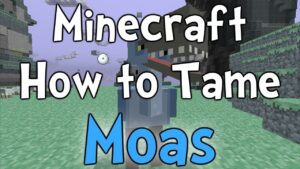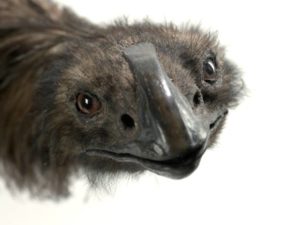1200: Domesticated Moa
July 22, 2021
By AHNZ
 So Minecraft has moas now and they can be tamed?
So Minecraft has moas now and they can be tamed?
Well, there may be precedent….
“We learn from Mr. Shand that the Moriori of the Chatham Islands kept sea-gulls, tern, and parquets tamed, and that they protected the wingless birds of the island, only allowing them to be taken for food at certain seasons. Is it not then probable that the New Zealand branch of the race was imbued with the same provident spirit, and that the inhabitants of the sound may have had moas tamed or partially domesticated? Throughout New Guinea tame cassowaries are common in the native villages. In the Solomon and other Melanesian groups the Megapoda has been introduced, and is so carefully protected that it may be considered a domestic animal. It would be quite in keeping with the genius of a Melanesian people if, on landing in New Zealand, they found the country tenanted by wingless birds, to preserve them as a means of subsistence.”- Joshua Rutland; JPS (1897)
“Whetu Paitai, Game Designer at Piki Studios, managed to fashion a Māori culture-based world in a period of five weeks. Labeled Ngā Motu (The Islands), the area features extinct Moa birds, along with native Kiwis, flocking around wooden fences in pā (villages). There’s also going to be harbors showcasing ancient canoe-like watercrafts known as waka hourua, and brave voyagers will soon be able to visit legendary water monster, taniwha, as well.” – Minecraft: Education Edition gets a new world focused on the Māori culture, Neowin (2019)
 Up until the establishment of the capital at Wairau in about 1280 the Moa Hunter culture appear to have been nomadic. Evidence of these people goes back to at least the 1100s where they seem to have wandered. Harvesting the seals, fish, whales, rats, tuataras and swans will have supplied plenty of easy calories.
Up until the establishment of the capital at Wairau in about 1280 the Moa Hunter culture appear to have been nomadic. Evidence of these people goes back to at least the 1100s where they seem to have wandered. Harvesting the seals, fish, whales, rats, tuataras and swans will have supplied plenty of easy calories.
They just had to watch out for the great predator, the Haast Eagle. This must have been especially true in the last days of the moa when competition between man and eagle was great. We should expect the Archaic East Polynesian Culture of New Zealand to have had very sharp eyes to the sky to beware of attack from above. They may also have had some specific protective technology such as weapons or mobile shelters to defend themselves that our archaeology may one day discover.
Perhaps the nomadic Moa Hunter traveled with domesticated moa, then, just as other cultures travel with goats. Perhaps, too, this relationship led to moa living with humans when they ceased being nomadic and settled in one place. Moa pasturalism!
“Established c.1902, the Helvetia Ostrich Farm ran a great trade while it lasted. These birds offer huge eggs, great meat, strong pelts and fast growth if they survive their vulnerable fledgling phase.” – AHNZ
“It is accepted that Captain Cook left pigs in New Zealand, their descendants still thriving today, on his first voyage. Unlike chickens, the pigs might have survived better because piglets do not need to be hatched from eggs; Rats make short work of eggs.” – AHNZ
Emus lay 25 eggs each year but they’re very big eggs. Raising moa chicks would provide an excellent source of meat, feathers, pelts, and egg-based dinnerware. A moa would make a snugly soft animal to sleep with in cold South Island winters while waiting for the electric blanket to be invented. A domestic moa may also prove a useful hunting ally when it came to catching more from the wild, a ‘Judas moa’.
Maoris never achieved this domestication of birds. In fact, when Captain Cook gave them domestic chickens to farm in the 1770s they abandoned them. If the Chatham Island Moriori could and did keep birds though (until they became conquered by the Taranaki, of course) then it is very reasonable to suppose, as naturalist Joshua Rutland did, that moa came under their repertoire too.
 Like Comment Share
Like Comment Share





